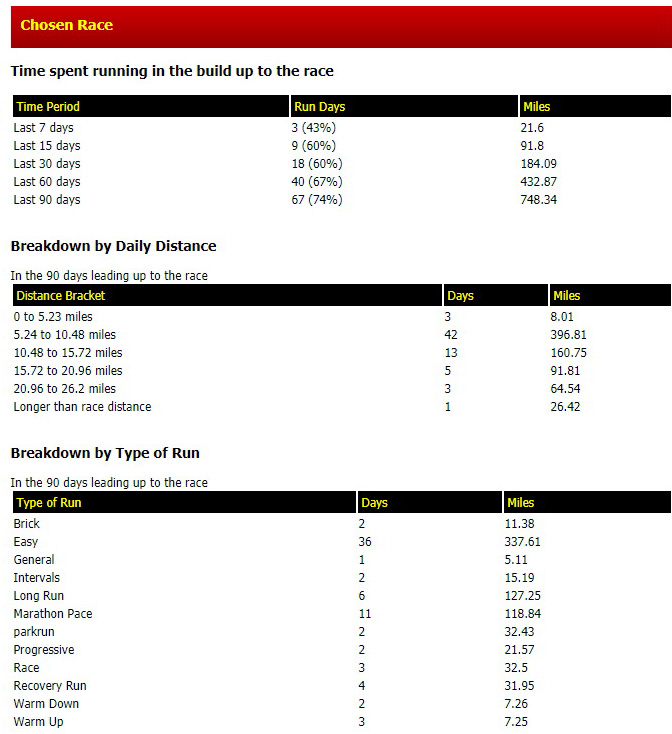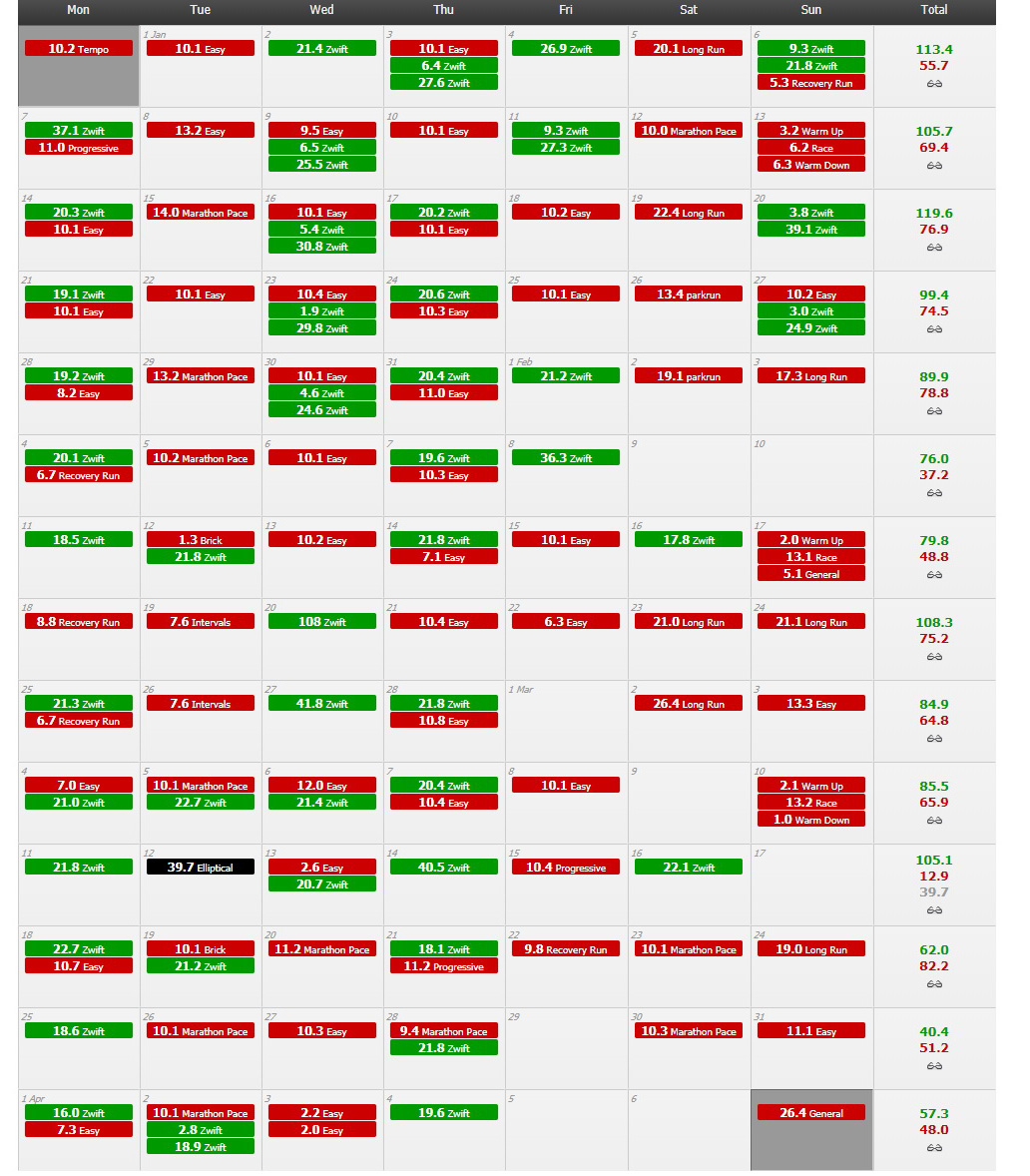The 2019 Manchester marathon training plan was a continuation of the key principals I have used in 2017 and 2018 with a few tweaks here and there based on what I thought worked well (and vice versa) in 2018 especially. These key components were:
• The marathon paced effort, in most instances run to a maximum HR (165) which is at the upper limit of my Zone 3. This has been at the core of my marathon training for well over ten years now. I build these up over the course of the weeks before the marathon, beginning with three miles (within a longer run) and building up a mile per session until I reach eight miles at marathon HR (MHR). After 2018 when I inadvertently ran around 13 miles at MHR on a twenty mile run when the Newton’s Fraction HM was cancelled, I used the Leicestershire Half Marathon in February to do much the same. This came when I was up to six miles at MHR, so in March I ran the seven and eight miles at MHR on March 5th and March 20th respectively.
Normally I would leave it there except run three miles at MHR a few days before the marathon. This time though I decided to do a reverse pyramid of sorts, running 7 miles at MHR on Saturday 23rd March then 6 miles on Tuesday 26th, 5 on Thursday 28th, 4 on Saturday 30th and the conventional 3 miles at MHR in a 10 mile run on Tuesday 2nd April. This was something of a high risk strategy as the MHR runs are quite demanding sessions. I think they were of some benefit, they certainly got me used to running at MHR and as they were diminishing in length certainly gave an impression of tapering.
As in previous years the majority of MHR runs were run a fair bit quicker than I anticipated running in the marathon itself – coming in anywhere between 5:45-6:10 minutes a mile. I usually see marathon pace on the day around 10 seconds a mile slower than I averaged during the build up, which tends to make the effort on race day seem less. I guess adrenaline accounts for the reduced pace at the same HR.

• The long run (with parkrun thrown in) and the back to back long run. The long run is a staple of any marathon training plan. Mine is no exception except for the past couple of years I’ve tried to incorporate a parkrun somewhere during the run. I kicked off on January 5 with a twenty miler, with the Belton House parkrun (17:35) coming after twelve miles. On January 19th I ran 22 miles with parkrun (18:16) at 14 miles. The other two Saturdays both had parkruns, one was shorter though at 10 miles due to the Oundle 10K on the Sunday, the other a mere 13.3 miles as I was feeling a bit rubbish.
February saw much of the same. The second saw a twist in that I ran just 2.5 miles before doing parkrun and then 13.5 miles to make it 19 in total. This wasn’t planned, it just happened that it snowed overnight and the paths were mostly too treacherous until it warmed up later in the morning. I then ran 17 miles the next day. The following weekend I was unwell so did nothing at all. The week was the Leicestershire Half so I didn’t run on the Saturday.
The following weekend (23rd-24th) I ran 21 miles (15 then parkrun (17:23) 3 to end) on the Saturday then ran a further 21 miles on the Sunday at 6:45 pace average. This back to back long run was something I inadvertently did once in 2018 due to bad weather preventing me from cycling and thought it offered significant training benefits so opted in 2019 to repeat the process with a little more regularity and intensity. This meant that the Reliability Rides with Witham Wheelers, which I’ve done for the past four years were sacrificed entirely.
Saturday 2nd and Sunday 3rd March saw the peak of long run mileage in the 14 week training plan. Saturday was the 24 miler which I’ve done since 2000 as my longest training run, except for the past two miles I’ve done a couple of extra to make it slightly over marathon distance. As in 2018 I ran the Newton’s Fraction HM course, running 21 miles before running Belton House parkrun in 17:51 then heading home to complete 26.4 miles in 2:55:46.
I’ve often used the time it’s taken to run 24 miles in this training run as a very good barometer of what I will clock at the marathon – it’s nearly always been accurate to a minute or two barring bad weather or a hitting of the dreaded wall. In 2018 I went through 24 miles in 2:39:10 (my quickest ever) this time around it was 2:40:10, which was a fair reflection of where I thought my fitness was – which was very good but not quite at 2018 levels, when I think I was in my best shape ever. The following day I ran a training half marathon in 1:29:58 or something like that, pleased that I could run such a distance in a reasonable lick a day after a 26 mile effort.
Thereafter the long run diminished quite rapidly. The following weekend was the Retford Half, the following weekend I opted out of running entirely as I was exhausted working crazy hours for the Australian GP. Two weeks out saw my last long run on the Sunday at 19 miles. That came the day after running seven miles at marathon pace and was so quite fatigued. It also saw some weird back spasm in the upper back in the final miles that didn’t materalise again. The following week, a week out, I ran my conventional final long run of eleven miles.
The stats state that for the ninety days preceding the marathon, I ran nine times over 15.72 miles totaling 182.74 miles in an overall total of 748.34 miles.
• The vast majority of the other runs were easy paced i.e. Zone 2, most of which ten or so miles in length, many of which on my familiar town loop – clockwise or anticlockwise. The average pace of these was around 7:10 a mile although the ones solo were more likely to be under 7 minutes a mile average and the runs with Grantham Running Club closer to eight minutes per mile, on average.
• I ran two intervals sessions, which is 200% more than 2018 and double what I ran in 2017. They were both 10×3 minutes with 90 seconds recovery, done on the road outside my house. I don’t really know if they had any benefit. It’s something I may look into doing more of over the summer as there must be some point in doing them?!
• As in previous years I cross-trained – cycling this time being used almost exclusively – the elliptical trainer saw just one outing when I had a sore calf after the Retford HM. This year was different from recent ones in that I didn’t venture outside once, doing all my cycling on Zwift. The main reason, other than wanting to do more back to back long runs over the weekend, being that I really did suffer far too much in the cold in 2018 especially and indoors on Zwift in the winter is so much more comfortable!
I spent a total of 65 hours 47 minutes on Zwift from January 1st through to the Manchester Marathon. I ran for 92 hours 38 minutes and spent just 2 hours on the elliptical trainer. The volume is similar to what I rode in 2018, the main difference being a lack of long Sunday rides. The majority of the rides were an hour or so in length, most of them relatively easy in effort, although I did push it on the Tour of Watopia and did ride 110 miles over the course of a very long day between F1 testing duties. As well as enjoying the cycling I think it compliments my running very well, especially the low effort rides which are the rough equivalent of recovery runs. Interestingly early indications suggest that the winter of Zwift has left my outdoor cycling legs in very similar, if not slightly better, shape to what they were at the same stage twelve months ago.
My weekly running mileage was similar to 2018. Coincidentally the biggest mileage of any week (82 miles) was the same, albeit in 2019 this was three weeks out from Manchester, in 2018, it came six weeks out from London. Interestingly though in 2018 there was only one other week where I ran over 70 miles (a 79 mile week). In 2019, I ran four other weeks over 70 miles and a further week where I ran 69. In January I ran 309 miles which is only five miles off my record, set in January 2014.
There was though one fallow week with very little mileage. This was due to to a spot of injury after Retford and opting to use Zwift rather than run during the Australian GP weekend. This was a conscious choice I made before the event looking back on previous years where I attempted to work through the Aussie GP weekend and have broken down at some point afterwards.
I don’t think this did me any harm at all.

All in all I think it was a very successful marathon training preparation, up there with the past couple of years as being the best ever. From an injury point of view it was very good, with just a couple of days lost after Retford with sciatica and an ongoing issue with a sore big left toe that hasn’t hindered my ability to run.
Is there anything I will do differently next time? In an ideal world I would probably want to add some more interval sessions in – something like some mile reps or two mile reps. But I seem to loathe interval sessions and as I run because I enjoy it I am reluctant to do them when I can be doing something that produces a similar benefit and I don’t mind doing (I’m reluctant to say like, as I dread the thought of marathon paced runs beforehand, but once I’m a mile or two in to them I really enjoy them!)
An important thing to note is that, aside from a minimum 24 mile run 4-5 weeks out and the marathon paced efforts over the course of the training, very little of what I do is planned weeks and months in advance. I have a rough idea of what I will do but take things very much on a week by week and day by day basis. I know some will question this but I’m comfortable with it. I much prefer to train according to how I feel right here right now rather than how I think I might or should feel months in advance then get frustrated when reality doesn’t quite pan out that way. Perhaps I may do better sticking to a plan, but things seem to have gone quite well for me in the years when I’ve been a bit more free form!
If you are wondering where I get all this data from. It comes from the very wonderful Fetcheveryone.com
I’ve been using this site since 2006 and all my exercise is recorded there. It has proven invaluable as a source of reference since then, I probably still use it more than Strava as the go to when I am looking back on my training history. Highly recommended!
